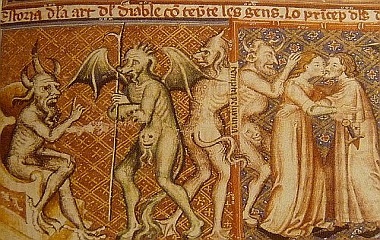Who is the Devil?
The Devil (also called Satan, Iblis, Lucifer, and Beelzebub) is a religious personification of evil. He works against god, employing an army of demons to harass humans and attempting to corrupt humans to do his bidding as well.
Characteristics
Physical Description
The Devil is a shapeshifter, so an exact description of his appearance is impossible. Nevertheless, he has a few classic shapes, which he uses over and over again.
Before he became “the devil,” he was either an angel (or a djinn, according to some Islamic sources) in God’s inner circle. Like other angels, he was ravishingly beautiful. He may have had wings and an aura of light around him.
After the Devil was cast out of heaven, he began taking on various, monstrous shapes. Serpents, pigs, and goats were some of his favorite shapes. Even when he wasn’t fully disguised as an animal, he liked to add some animalistic traits to his shape. For example, he might appear as a man with goat’s hooves and horns or with a serpent’s scaly skin. His skin was also discolored; it could be blue, green, or black, but red was the most popular color.
Perhaps the Devil’s most sinister form is his human one. He can easily blend in with a crowd by posing as a human—usually an attractive, wealthy male.
Personality
The Devil is a troublemaker; this is something that very few people dispute.
In the beginning, the Devil’s main fault was probably pride. He was cast out of heaven because he refused to bow to man, reasoning that God had made man out of earth and angels (or djinn) out of fire. Therefore, he should be superior to man.
When God denied the Devil’s superiority and banished him to earth, his pride was severely wounded. He vowed get revenge against God and mankind.
But he was too clever to attack mankind outright. Instead, he decided he would corrupt the species, thus disgracing God and forcing the creator to punish mankind. The Devil devised infinite ways to tempt mankind into sinful behavior. He offered wealth to greedy men, revenge to wrathful men, luxury to lazy men, sex to lusty men, and so forth.
This scheme, which succeeded in corrupting countless humans and spreading sin all over the world, earned the Devil a reputation as a purely evil spirit, with a powerful knack for temptation and deceit. However, a small camp of people admire the devil for his shrewd intelligence and rebellion against God, an authority who asked him to go against his own beliefs.
Cultural Representation
Origin
Devilish characters, who oppose the order of good creators, can be found in humanity’s earliest religions.
In 3000 BC, the ancient Egyptians dreaded Apep, the god of chaos, who defied Ma’at, the god of light and truth. Zoroastrinism, which dates back to the 6th century BC, has a “destructive spirit” named Angra Mainyu who is the twin spirit of the creator, Spenta Mainyu. And the ancient Greeks, who probably had the strongest influence on the Devil, described the chaotic, half-goat Satyrs disrupting the rule of the gods.
Jewish Devil
Although most Jewish people today could tell you who the Devil is, he was not a prominent character in early Judaism at all. In fact, he only appears once in the Torah, as a tempter who convinces God to test Job by taking away his wealth and family.
The idea of a powerful Devil contradicts the Jewish faith, which claims that there is only one deity, and none can approach his power.
Still, there are a few Jewish, religious texts which expand upon the existence of a Devil. The Book of Enoch gives various examples of the Devil (Satan) tempting God or humans into bad behavior. It also describes Satan being cast from heaven, along with a troop of other angels.
Christian Devil
The Christian Devil is much more powerful than the Jewish Devil. He is described throughout the Bible as “the prince of this world” and even as “the god of this world,” and he is seen tempting humans from the very start, when he appears as a serpent to convince Adam and Eve to eat forbidden fruit. He also tempts powerful beings, including the apostles and even Jesus himself.
The early Christian church believed in the Devil and his demons as a very real force, constantly trying to corrupt mankind. The church’s belief in a literal devil led to many horrific events. The church felt justified in attacking people who were “possessed” by the Devil, usually heretics or witches. The Church also claimed that anyone who disobeyed their rules would be forced to join the Devil in the Hell which God had created to punish him.
Today, many Christians favor a non-literal interpretation of the Devil. Rather than a spirit running rampant among us, they describe the Devil as a symbol for base human instincts.
Islamic Devil
The Quran spends more time developing the Devil (Iblis) than any other religious text. The book gives him a complex back story, describing him as a djinn who fought for God when the world was overrun with evil spirits. In response, God gave Iblis a place among his elite angels, but when Iblis refused to bow to Adam, God cast him back to Earth.
Most Islamic believers see Iblis as the enemy of humanity, not the enemy of God. He spreads chaos and destructive habits because he hates the descendants of Adam. However, his schemes can easily be thwarted by calling upon God.
Modern Appearances
Today, the Devil is so well known that his name can be used to describe anyone or anything that causes frustration (“that man is a devil” or “this is a devilish puzzle”). Countless horror movies, TV shows, and books use the Devil as an ultimate villain—usually detectable only through his influence on lesser villains.











